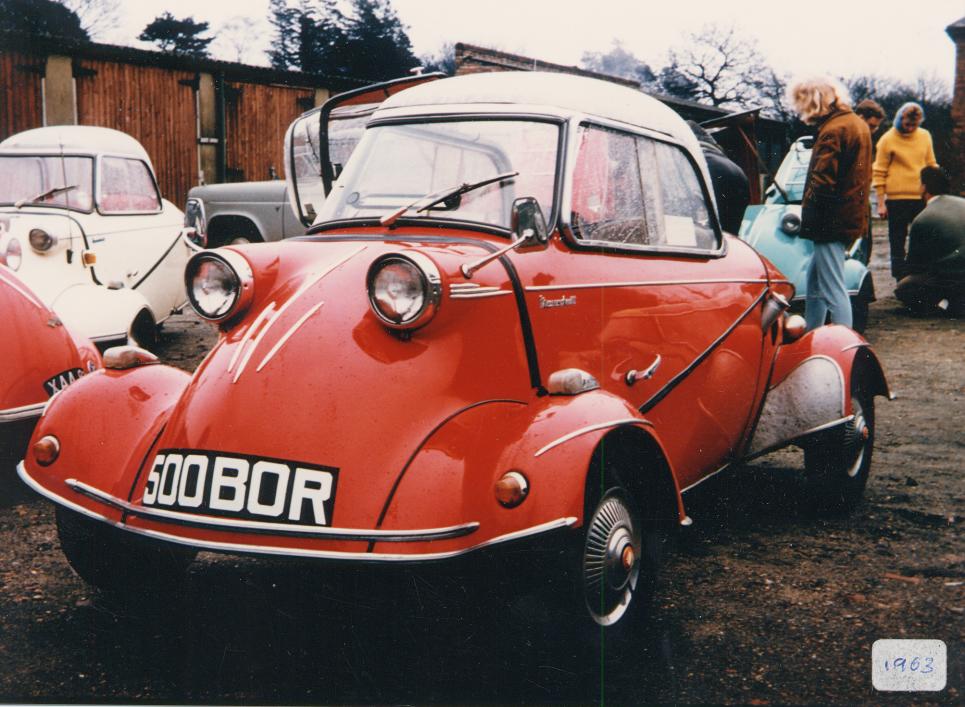History of the high performance TG500
- Home
- History of the high performance TG500
-
By: admin
- 0 Comments

Launched in May 1958 to great acclaim from Messerschmitt fans in Britain, who were impatient for its arrival. Four months later, it reached us and we were not disappointed. Our Club welcomed Herr and Frau Fend for the first time for the official British launch of the Tiger on 29th September that year at Brands Hatch Circuit. In a typical gesture, Ing. Fend who learned of a meeting of our Club, voluntarily drove 200 kilometres further north to give us an unofficial demonstration one day before this amazing sports car was shown to the British press and public.
After the KR200 model variants were introduced, tests on the first four wheeled KaRo- the “Tiger” began in September 1957. The sales were aimed at existing KR 200 owners who had developed a faithful following in Germany with the many Karo Clubs. For legal reasons, the “Tiger” could only be called the “Tg”, (Tiger was also used by Sunbeam and Panhard). Only 198 examples can be traced of which 160 are known to exist today. The most sought after of Messerschmitts, (though it never bore that name – it was normally registered as an FMR). Surprisingly, the car cannot be called a Messerschmitt because it was built by FMR and this company was not authorised to apply that name to anything but the KR175, KR 200, and KR201. You will not see the Messerschmitt scrip badge applied to the lifting section on a Tg. Sports-car handling and high top speed brought many rally successes in the early sixties, particularly at the hands of Ken Piper. It was so good that the Rally organisers sought to exclude it from competition events where it took on all comers, including the most exotic sports-cars. It has a 460cc air-cooled twin 2-stroke engine, nominally of 26bhp though most have been up-rated now. A Fichtel & Sachs design with four forward and a reverse gearbox with integral differential.
It was seen in all four body variants available on the KR200. With only 26 examples in the U.K. prices are extremely high and around three times that of a KR200. Although externally similar to the KR200, there is almost nothing the same. The lifting section is perhaps the only large component which is identical. In the late sixties and early seventies there was no organised parts service for the Tgs. A few owners said that good KR200 could be a close match to a Tg when it came to handling and acceleration through the gears. In addition, the U.K. the road tax applied to four wheeled vehicles was a serious consideration. Much more is known now about the performance and development of the engine and the improved designs of the later models have been applied to the early ones. Most now have uprated engines so the comment that a good KR200 is a close match, no longer applies.
The Tg500 was always difficult to obtain parts for, although surprisingly, the parts today are easier to obtain than they were during the years of production. This is thanks to the efforts of Heiko Zimmermann, from Neuss, Germany. Heiko has owned Tg500s for many years and organises spare parts for the remaining 199 documented production cars. Some years ago he produced a detailed history of every known vehicle, a task which represents hundreds of hours of work!
The engine is a 460cc twin cylinder two stroke which develops 23bhp. This does not make it much faster than the KR200, the wind resistance from those large rear wings see to that! The gearbox is conventional and similar to many vehicles of that era. Gear changes are hampered by the lack of Synchromesh, something that we take for granted in todays cars. The engine was originally a Fichtel & Sachs design but was manufactured by FMR from components provided by outside specialist suppliers. It is thought that around 700 were made, these being used in the Australian Zeta sportscar and the Kultimax agricultural vehicle. The design is very similar to the Goggomobil and NSU engines of the same era. Unlike the KR200, the engine comes apart vertically, leaving all the components sitting in the lower engine half. The aluminium castings are very poor quality and great care must be taken when tightening any engine bolts as stripped threads are a constant hazard. A torque wrench is an essential tool for working on the engine.
A number of replicas have been built with authentic sounding versions using a Trabant engine and gearbox. Others have used Renault 4 cylinder units that are quiet and reliable but lack the authentic two-stroke sound.
Prev Post
KR201 History
Next Post
Messerschmitt Sport (the..
Related Post
- May 3, 2019
